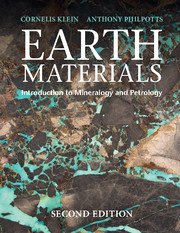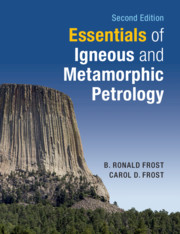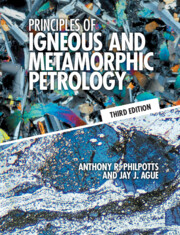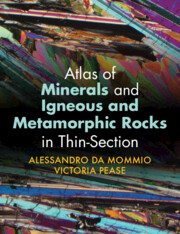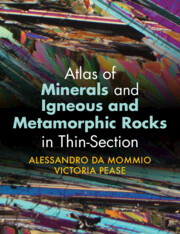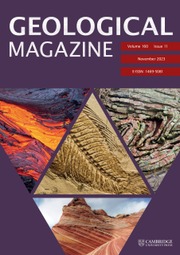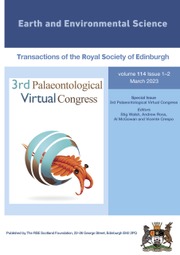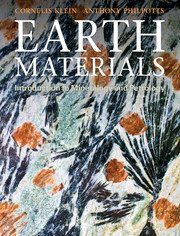Earth Materials
This concise, accessible, market-leading textbook brings together the wide-ranging fundamentals students need to understand rocks and minerals, and shows them how they relate to the broader Earth, materials and environmental sciences. Designed specifically for one-semester courses, it is beautifully illustrated to explain the key concepts in mineralogy and petrology. This edition has been fully updated based on classroom experience, and new features include a completely new chapter providing an elementary introduction to thermodynamics, kinetics, radioactive decay and absolute dating; new mineral descriptions and many new stunning color photographs; and a new section on hydraulic fracturing and discussion of some of its most serious potential environmental consequences. The book uses stunning photos of mineral specimens and rock thin sections to help students build a core understanding. It also creates a highly effective learning experience through close integration of clear illustrations with engaging text, and helps students to easily visualize crystal structures through the CrystalViewer's 3D software, available online.
- Brings together all the wide-ranging fundamentals needed to understand rocks and minerals in a concise textbook
- Shows how minerals and rocks relate to the broader Earth sciences, materials sciences and environmental sciences
- Stunning color photos of specimens and CrystalMaker's 3D illustrations allow students to easily visualize minerals, rocks and crystal structures
- Online resources include CrystalViewer's 3D rotatable crystal structures, animated phase diagrams, answers to end-of-chapter student exercises and all the figures from the book as PowerPoint and JPEG files for instructors
Reviews & endorsements
'Earth Materials is a magnificent textbook that illustrates in a wonderful way how petrology and mineralogy relate to our planet Earth, its formation and modification by igneous, metamorphic and sedimentary processes. Outstanding photographs and detailed thin section images are neatly combined with clear illustrations, fostering the link between observations and fundamental theoretical principles. A new section in the second edition about thermodynamics and kinetics nicely complements the thorough coverage of key concepts in petrology and mineralogy. The available online resources are an essential aid for teaching, and students will benefit from the review questions at the end of each chapter. Earth Materials is simply a great textbook, which I can highly recommend.' Ralf Halama, Keele University
'Earth Materials captures the fundamentals of mineralogy and petrology in a one-semester text in a surprisingly thorough and direct way. This book can be successfully used for both one-semester courses and two-semester sequences. My students appreciate the clear, color images, and I appreciate the depth of information provided.' Christine M. Clark, Eastern Michigan University
'There is an increasing trend to condense mineralogy and petrology into a one semester course, and Earth Materials - An Introduction to Mineralogy and Petrology authored by Klein and Philpotts, provides the perfect textbook for such a course. It is extensive enough to supply fundamental information on mineralogy and petrology separately, while also seamlessly integrating these two subjects into a cohesive entity. Most impressive to me are the extensive colour figures and thin sections for most of the rock types.' Zhaohui (George) Li, University of Wisconsin
'I have used this textbook in my undergraduate Earth Materials course since its publication in 2013, and the second edition adds important new elements, including a more comprehensive treatment of thermodynamics and phase equilibria. The components that made the first edition so welcome are still here: the integration of crystallography with sedimentary, igneous, and metamorphic geology; the colorful images of atomic structures, minerals and geologic localities; and the consideration of the role that minerals play in our society. It is by far the best text for those of us who have to cover all the mineralogical and petrological bases in one semester.' Peter J. Heaney, Pennsylvania State University
'I really like the way this book organizes the subjects of mineralogy and petrology to emphasize the connection between plate tectonics, mantle processes, mineral stability, and rock composition. Teaching with this organization clearly reinforces the big picture of geologic processes while digging into enough depth in each subject area to prepare students to tackle integrated geologic problems.' Alexis Sitchler, Colorado School of Mines
'Brilliant! Absolutely brilliant! A landmark text in the Earth Sciences for modern times! The color illustrations, figures and photographs of all things geologically important, accompanied by lucid text, will seductively attract young minds. The chapters covering wide-ranging topics are all relevant for 21st century students of Earth and material science. I can't think of a better text that is a 'must buy' for our undergraduates.' Asish R. Basu, University of Texas, Arlington
'This latest edition includes a number of new topics …The authors discuss concepts such as heat, work, internal energy, enthalpy, Gibbs free energy, and entropy in a simple, intuitive fashion that most any reader can understand and appreciate … Phase diagrams show the stability fields of minerals in terms of temperature and pressure, and temperature and composition. Another addition to the book is a section on the use of hydraulic fracturing to extract shale oil and gas prospects and its implications on the environment. The authors treat this last topic in a fair and open manner, admitting the potential risks, but also acknowledging the benefits of having this technology to meet the world's energy needs.' The Leading Edge
Product details
December 2016Paperback
9781316608852
616 pages
275 × 220 × 22 mm
1.69kg
1076 colour illus. 30 tables 360 exercises
Available
Table of Contents
- 1. Introduction
- 2. Materials of the solid Earth
- 3. How are minerals identified?
- 4. Fundamentals of crystal structures
- 5. Introduction to crystallography
- 6. Minerals and rocks observed under the polarizing optical microscope
- 7. Igneous rock-forming minerals
- 8. The direction and rate of natural processes: an introduction to thermodynamics and kinetics
- 9. How do igneous rocks form?
- 10. Igneous rocks: their mode of occurrence, classification, and plate tectonic setting
- 11. Sedimentary rock-forming minerals and materials
- 12. Formation, transport, and lithification of sediment
- 13. Sedimentary rock classification, occurrence, and plate tectonic significance
- 14. Metamorphic rock-forming minerals
- 15. Metamorphic rocks
- 16. Some economic minerals, mainly from veins and pegmatites
- 17. Some selected Earth materials resources
- 18. Earth materials and human health.

